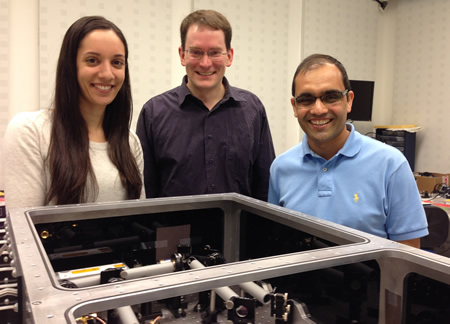
Allison Solanki, Michael Woodside and Krishna Neupane. Photo by Suzette Chan.
(Edmonton) Neither Allison Solanki nor Krishna Neupane had a background in biology before they came to the University of Alberta. Now, they are co-authors of two biophysics papers about a protein associated with Parkinson's disease.
Grad student Solanki and postdoctoral fellow Neupane both work with Physics professor Michael Woodside, who studies misfolded proteins and their possible role in causing neurodegenerative diseases.
Portland native Solanki studied physics at Whitman College and decided to take a further look into biophysics after one particular research job. "The summer before I came here, I did research on biosensors involving protein," she says. "It was interesting and I knew it was a growing field."Neupane, originally from Nepal, says, "I did not have a biology background until my PhD at Kent State. I studied liquid crystals. The close association of liquid crystals to biology as well as my experience in instrumentation and data analysis interested me in Michael Woodside's research."
Neupane and Solanki are looking at the physical properties of the protein alpha-synuclein, which forms aggregates that are a characteristic feature of Parkinson's disease. Alpha-synuclein is a so-called 'intrinsically disordered protein' (IDP), a class of proteins with no stable structure in their normal state. "As a result, structural fluctuations are larger and more important for them than for 'regular' proteins that take on a well-defined structure," says Woodside.
Both recent papers explore the question of structural fluctuations of the protein. To make these observations, Woodside's team built optical traps to manipulate individual protein molecules. These tiny optical tweezers - controlled by everyday gaming joysticks - were used to grab the ends of the molecules and pull them apart so that the team could detect if structures had formed transiently in the nominally disordered protein. These structures then reflect the fundamental physical characteristic of the protein which drives structure formation, known as the 'folding landscape'.
"No one had measured this protein using optical traps before," says Solanki, who also helped make the protein samples. "From the research we've conducted so far, we've found an amazingly complex landscape."Neupane described their work as "observing various aggregation species and finding how they link to disease parameters."
From physics to instrumentation to biological study, Neupane and Solanki's interdisciplinary work is actually part of a larger collaboration.
Chemistry professor Nils Petersen's group "is working on the formation of small aggregates using a separate technique, based on fluorescence," says Woodside. "He has a student studying the uptake of these polymers into the cell."
In addition, medical physics professor Jack Tuszynski is contributing computational expertise. One member of Tuszynski's team, Physics graduate student Mark Healey, is creating computer simulations of the structural fluctuations in the protein, including simulations that mimic the conditions of the pulling measurements. "This work allows us to map our experiment to the simulations and vice versa," Woodside says, providing insight into what structures are forming.
One of the goals of the experiments is to identify and test new drug targets, but first Woodside, Neupane, Solanki and their collaborators have more to learn about the structure of the protein.
These experiments give us the first look at the wide variety of structures that can be formed by small oligomers ('clumps') of proteins," Woodside says. "Next up is to identify which, if any of them, are important steps on the way to generating the structures that are toxic. One way to do this is to look at how the behaviour changes when we introduce mutations in the protein that cause inherited forms of Parkinson's disease."